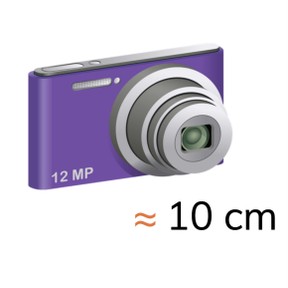
Estimating length in centimeters
Students learn to estimate length in centimeters.



8,000 schools use Gynzy
92,000 teachers use Gynzy
1,600,000 students use Gynzy
General
Students learn to estimate the length of familiar objects in centimeters.
Common core standard(s)
CCSS.Math.Content.2.MD.A.3
Learning objective
Students will be able to estimate the length of familiar objects in centimeters.
Introduction
Have the students discuss in groups. Together, they have to think of five objects that are larger than one centimeter and five objects that are smaller than one centimeter, as fast as they can. As soon as they have written all of the objects, the whole group stands up to show that they are done.
Instruction
Explain what a centimeter is. Show that the section on the ruler from 0 to 1 is exactly one centimeter long. State that your thumb is about one centimeter wide. Show this with help from the ruler. Explain that you can estimate the length of objects by comparing it with the width of your thumb. This is because you already know that your thumb is about one centimeter wide. Explain that with an object that is larger than 10 cm, students can also use the distance from their thumb to the tip of their pointer finger. This makes it easier to measure the length of a table, for example. Next, have the students take an object, for example from their pencil case, and have them estimate the length of that object. Choose several of the students' objects and ask what they estimated and how they did that. Also ask what other students estimate that object's length to be. After students have given an answer, you can measure the object to find out which estimation was the closest. Next, you show a few statements on the interactive whiteboard. The students must answer whether each statement is true or false. Then the students must estimate how long an object is in real life. They can choose from a number of possible answers.
To check that students can estimate the length of objects in centimeters, you can ask the following questions:
- What is about one centimeter?
- How can you estimate the length of an object?
Quiz
The students first practice with a statement about the length of an object in centimeters. Then they must estimate the length of the object, for which they can choose from several possible answers.
Closing
You discuss with the students again how it is useful to be able to estimate the length of objects, so that you know about how long something is. You check if the students can estimate length using several objects on the interactive whiteboard. With each object there are possible answers. Next to each object is a section of an an image. The students must state what the correct answer is. Then, drag the image sections to the correct answer box. In this way you complete the puzzle to form a complete image.
Teaching tips
When students have trouble estimating the length of objects, you can remind them that the width of your thumb is about one centimeter and the distance between your thumb to the tip of your pointer finger is about 10 cm. You can compare real objects to your thumb or hand. This is how you can estimate the length of an object.
Instruction materials
A ruler.
The online teaching platform for interactive whiteboards and displays in schools
Save time building lessons
Manage the classroom more efficiently
Increase student engagement
Discover more!
About Gynzy
Gynzy is an online teaching platform for interactive whiteboards and displays in schools.
With a focus on elementary education, Gynzy’s Whiteboard, digital tools, and activities make it easy for teachers to save time building lessons, increase student engagement, and make classroom management more efficient.



